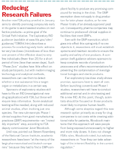Washington Report: Labels and Liability
Pharmaceutical Executive
Pharmaceutical companies are worried that FDA's new labeling format will expose them to liability suits from individuals who suffer adverse events that are not highlighted, but "hidden" in the full prescribing information.
The food and drug administration started 2006 with a bang, unveiling a long-anticipated final rule that significantly overhauls the way drugs and biologics are labeled. This new regulation, designed to improve the communication of risks and benefits, has been in the works for years, but has been delayed by industry concerns that it could expose companies to more liability suits. Implementation will be a massive, costly undertaking, but at this point industry has little choice but to comply.

Jill Wechsler
This final decision on the format and content of professional labeling sets the stage for FDA to move forward with other initiatives. For example, the agency recently required manufacturers to submit all labeling
in electronic form. That process should finally move ahead now that FDA has eliminated uncertainty about label design. Similarly, it will now be safer and easier for manufacturers to simplify the brief summary that accompanies print advertising, as FDA wants: The "highlights" section at the beginning of the new label provides a model for developing briefer and more consumer-friendly prescribing information.

Reducing Research Failures
New Challenges
Although the basic framework of the new labeling rule surprised no one, compliance will require significant investment by manufacturers. To meet the new design and content requirements, most professional labels (also known as "package inserts") will be twice as long, requiring manufacturers to change packaging lines and label printing operations for many products. FDA agreed to keep type fonts fairly small, but many new labels will need an additional page, which represents a big expenditure.
The most significant change is the new highlights section, which summarizes a product's most important prescribing information, including boxed warnings, approved uses, recommended doses, warnings, and adverse events. (Links to the new rule, agency guidances, sample labels, and guides for consumers and healthcare providers are available at www.fda.gov/cder/regulatory/physLabel/default.htm).
The new label includes a table of contents, offering a guide to full prescribing information. Overall, the new label gives more prominence to safety issues, such as drug-drug interactions and prescribing limits, and shifts more technical sections to the bottom. All labels now will include clinical trial results and toxicology data, and a concluding Patient Counseling Information section, which will reiterate the most important uses and limitations of the medication in order to help physicians discuss risks with patients. Any FDA-approved patient information or MedGuide has to accompany the full label or be added on at the end.
Of interest to marketers is the provision requiring labels to include the results of clinical trials. In a separate guidance FDA explains that it is looking for information on effectiveness drawn from well-controlled studies—and not data on unapproved uses or unsubstantiated comparative claims. FDA seeks consistent data for product classes and indications, as well as across drug classes, to establish a clear basis for promotional claims by competitive products.
The agency is phasing in compliance with the requirements, starting with new drugs and eventually covering all products approved within the last five years and older products making important label changes. Although most older drugs will not be required to adopt the new format, FDA hopes that many will do so.
Preempting States
While the highlights section may be useful to prescribers and patients, pharma companies worry that this format will expose them to liability suits from individuals who suffer adverse events that are not highlighted but "hidden" in the full prescribing information. Industry also fears that a dual-label system will generate claims that products with old labels fail to adequately warn of safety issues.
To address these concerns, FDA added to the preamble of the final rule (published in the January 24, 2006 Federal Register) a discussion of how FDA-approved drug labeling—in both old and new formats—preempts conflicting or contrasting state consumer protection laws that add warnings and other information to drug labels. FDA states that it has prime responsibility for determining the content and scope of drug labeling, and that states may dilute important safety information by requiring extraneous or unscientific material.
In fact, some state requirements might compel a manufacturer to make unsubstantiated statements that violate FDA policy, pointed out attorney Richard Kingham at a recent Drug Information Association meeting. He considers FDA's preemption statement a "very important development," but one that makes it critical for companies to keep approved labeling accurate and up to date. Plaintiffs' lawyers will be looking hard for omissions in safety information submitted to FDA in bringing liability cases, he notes. In addition, some members of Congress have called for legislation to remove the preemption language in response to charges from state officials that FDA is overstepping its authority.
One immediate result will be more intense labeling negotiations between sponsors and FDA reviewers. Pharma companies want to highlight as many adverse events as possible, while FDA seeks to reduce the clutter that detracts from serious safety messages. There will be a lot of discussion about which precautions and warnings go where, and what clinical study data can be cited to support marketing claims.
The final rule should support expansion of FDA's e-labeling program, designed to transmit approved labeling to the DailyMed online health information clearinghouse operated by the National Library of Medicine. The e-labeling system benefits marketers by permitting them to revise sections of approved labeling without changing the entire document, and electronic tags on label data will allow physicians to search for information by indication and by product. Eventually, this data will populate a "facts@fda" website offering comprehensive information on all FDA-regulated products. E-labeling also will support a paperless labeling initiative that manufacturers have been developing for the past decade and e-prescribing activities, which promise to reduce prescribing errors and inappropriate drug use.
Jill Wechsler is Pharm Exec's Washington correspondent. She can be reached at jwechsler@advanstar.com

FDA Grants Priority Review to Regeneron’s Eylea for Macular Edema Following Retinal Vein Occlusion
April 18th 2025Regulatory action was based on data from the Phase III QUASAR trial, which demonstrated that Eylea HD dosed every eight weeks achieved non-inferior visual acuity outcomes compared to Eylea in patients with macular edema following retinal vein occlusion.
Navigating Distrust: Pharma in the Age of Social Media
February 18th 2025Ian Baer, Founder and CEO of Sooth, discusses how the growing distrust in social media will impact industry marketing strategies and the relationships between pharmaceutical companies and the patients they aim to serve. He also explains dark social, how to combat misinformation, closing the trust gap, and more.